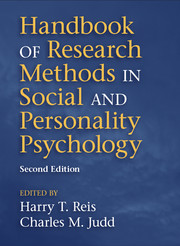Crossref Citations
This Book has been
cited by the following publications. This list is generated based on data provided by Crossref.
Homan, Astrid C.
Knippenberg, D.L. van
van Kleef, Gerben A.
and
De Dreu, Carsten K. W.
2005.
Interacting Dimensions of Diversity: Cross-Categorization and the Effects of Informational Diversity.
SSRN Electronic Journal,
Curhan, Jared R.
Elfenbein, Hillary Anger
and
Eisenkraft, Noah
2008.
The Objective Value of Subjective Value: A Multi-round Negotiation Study.
SSRN Electronic Journal,
Reb, Jochen
and
Narayanan, Jayanth
2009.
Breathe Your Way to a Good Deal: The Effect of Concentration Exercises on Negotiation Outcomes.
SSRN Electronic Journal,
Reb, Jochen
and
Narayanan, Jayanth
2011.
Mindfully Eating Raisins Improves Negotiation Success: The Effect of Mindfulness on Negotiation Performance.
SSRN Electronic Journal,
Lyusin, Dmitry
and
Ovsyannikova, Victoria
2014.
A New Videotest for Measuring Emotion Recognition Ability.
SSRN Electronic Journal,
Beerbaum, Dirk
2015.
Towards an XBRL-Enabled Corporate Governance Reporting Taxonomy: An Empirical Study of NYSE-Listed Financial Institutions.
SSRN Electronic Journal,
Beerbaum, Dirk
2015.
Towards an XBRL-Enabled Corporate Governance Reporting Taxonomy An Empirical Study of NYSE-Listed Financial Institutions.
SSRN Electronic Journal,
Extremera, Natalio
and
Rey, Lourdes
2015.
The moderator role of emotion regulation ability in the link between stress and well-being.
Frontiers in Psychology,
Vol. 6,
Issue. ,
Martin Guha
2015.
APA Handbook of Personality and Social Psychology.
Reference Reviews,
Vol. 29,
Issue. 5,
p.
10.
Fiske, Susan T.
2015.
Grolar bears, social class, and policy relevance: Extraordinary agendas for the emerging 21st century.
European Journal of Social Psychology,
Vol. 45,
Issue. 5,
p.
551.
Albert, Alex
Hallowell, Matthew R.
Lingard, Helen
and
Kleiner, Brian M.
2015.
Multiple Baseline Testing: Experimental Method for Drawing Causal Inferences in Construction Engineering and Management Research.
Journal of Construction Engineering and Management,
Vol. 141,
Issue. 7,
Mohamed-Salah, Boukhechem
and
Alain, Dumon
2016.
To what degree does handling concrete molecular models promote the ability to translate and coordinate between 2D and 3D molecular structure representations? A case study with Algerian students.
Chemistry Education Research and Practice,
Vol. 17,
Issue. 4,
p.
862.
Chan, Yvonne Y.
Gonzalez, Rafael G.
and
Shindel, Alan W.
2016.
Contemporary Treatment of Erectile Dysfunction.
p.
361.
Ryan, Sarah
and
Ream, Robert K.
2016.
Variation Across Hispanic Immigrant Generations in Parent Social Capital, College-Aligned Actions, and Four-Year College Enrollment.
American Educational Research Journal,
Vol. 53,
Issue. 4,
p.
953.
Kubovcikova, Annamaria
2016.
Going through the motions.
Journal of Global Mobility,
Vol. 4,
Issue. 2,
p.
149.
Dollimore, Denise E
and
Page, Nadine
2016.
Measuring Cognitive and Behavioural Habit Systems of Entrepreneurs.
SSRN Electronic Journal,
Dorfleitner, Gregor
Hornuf, Lars
and
Weber, Martina
2017.
Dynamics of Investor Communication in Equity Crowdfunding.
SSRN Electronic Journal ,
Fayant, Marie-Pierre
Sigall, Harold
Lemonnier, Aurore
Retsin, Emilie
and
Alexopoulos, Theodore
2017.
On the Limitations of Manipulation Checks: An Obstacle Toward Cumulative Science.
International Review of Social Psychology,
Vol. 30,
Issue. 1,
p.
125.
Balters, Stephanie
and
Steinert, Martin
2017.
Capturing emotion reactivity through physiology measurement as a foundation for affective engineering in engineering design science and engineering practices.
Journal of Intelligent Manufacturing,
Vol. 28,
Issue. 7,
p.
1585.
Bălău, Nicoleta
and
Utz, Sonja
2017.
Information sharing as strategic behaviour: the role of information display, social motivation and time pressure.
Behaviour & Information Technology,
Vol. 36,
Issue. 6,
p.
589.



